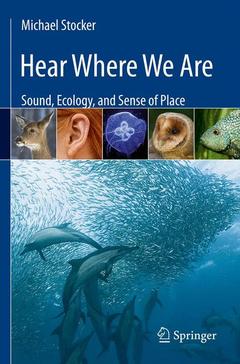Description
Hear Where We Are, 2013
Sound, Ecology, and Sense of Place
Author: Stocker Michael
Language: English
Subjects for Hear Where We Are:
Approximative price 26.36 €
In Print (Delivery period: 15 days).
Add to cart200 p. · 15.5x23.5 cm · Paperback
Description
/li>Contents
/li>Biography
/li>Comment
/li>
Throughout history, hearing and sound perception have been typically framed in the context of how sound conveys information and how that information influences the listener. "Hear Where We Are" inverts this premise and examines how humans and other hearing animals use sound to establish acoustical relationships with their surroundings.
This simple inversion reveals a panoply of possibilities by which we can re-evaluate how hearing animals use, produce, and perceive sound. Nuance in vocalizations become signals of enticement or boundary setting; silence becomes a field ripe in auditory possibilities; predator/prey relationships are infused with acoustic deception, and sounds that have been considered territorial cues become the fabric of cooperative acoustical communities. This inversion also expands the context of sound perception into a larger perspective that centers on biological adaptation within acoustic habitats. Here, the rapid synchronized flight patterns of flocking birds and the tight maneuvering of schooling fish becomes an acoustic engagement. Likewise, when stridulating crickets synchronize their summer evening chirrups, it has more to do with the ?cricket community? monitoring their collective boundaries rather than individual crickets establishing ?personal? territory or breeding fitness.
In "Hear Where We Are" the author continuously challenges many of the bio-acoustic orthodoxies, reframing the entire inquiry into sound perception and communication. By moving beyond our common assumptions, many of the mysteries of acoustical behavior become revealed, exposing a fresh and fertile panorama of acoustical experience and adaptation.
Dr. Stocker is currently the Director of Ocean Conservation Research, seeking solutions to the growing problem of human-generated ocean noise pollution though science, technology, policy development, and public outreach.
Reveals many of the mysteries of human and animal acoustical behavior, exposing a fresh and fertile panorama of acoustical experience
Offers unique insights and encompassing information on sound in environments ranging from ocean floors to Gothic cathedrals
Poetic and informative descriptions stir the reader to imagine the world of sound as animals perceive it: from the lateral lines of fish, to the whiskers of seals, and the "acoustical daylight" of snapping shrimp
Includes supplementary material: sn.pub/extras
These books may interest you

Acoustical Imaging 52.74 €



